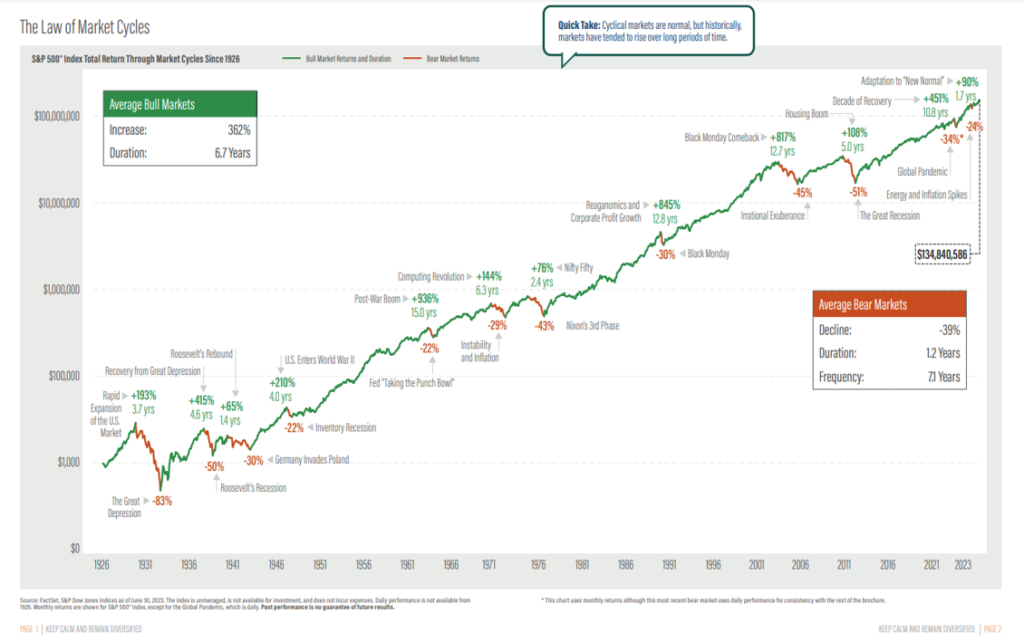
Markets Up or Down? Either Way, You Can Benefit with Intentional, Careful Trading Strategies.
Markets go up and markets go down over the course of an economic cycle, but the long-term trend is “Up and to the Right”, making all downturns thus far temporary. Why not take advantage of the dips as well as the gains? We believe you can benefit from either condition. Here’s how. Simply make lemonade from lemons.
Let’s Take Advantage of the Green AND the Red

When markets are temporarily down, Tax Loss Harvest (TLH):
- Offset realized Capital Gains for the current year
- Reduce $3000 of Ordinary Income
- Bank any remainder for use in future years. There is no limit to the amount which may be carried forward; and, they can be used through the year of your death (2nd to die for couples).
When markets are up, Tax Gain Harvest (TGH) in the most tax-efficient manner:
- In retirement accounts: To mitigate the need to recognize a Capital Gain in a taxable account for portfolio rebalancing.
- In taxable accounts: Rebalance to a target allocation with less tax impact to the extent the Capital Gains can be offset with “banked” Capital Losses.
- To harvest as many gains as possible at the 0% Capital Gains Rate.
- To “re-set” the cost basis of selected securities at the higher, current Market Value.
- To take gains at the 15% Capital Gains Rate if anticipated to be in the higher 20% Capital Gains Bracket (20%) in future years when proceeds will be needed.
When possible, it is better to take Long-Term(LT) Capital Losses, as they provide a tax-rate arbitrage as your Capital Gains Rate (0%, 15%, 20%) is typically lower than your Ordinary Income Rate (10% to 37%). You can use the LT Losses to offset the Short-Term (ST) Capital Gains which are taxed at the higher, Ordinary Income Tax Rate. However, at the end of each calendar year, it is worth evaluating if taking additional Short-Term (ST) Capital Losses – presuming no additional LT Capital Losses are available – will reduce your overall tax bill by offsetting ST Gains, LT Gains, and the allowable $3000 of Ordinary Income. If so, we consider this rate tradeoff worthwhile.
The Tactics
An example should help explain how these strategies get executed.
We are going to start by pretending that you invested $100,000 in the US Large Cap Stocks asset class by purchasing the Vanguard 500 Exchange Traded Fund (ticker symbol: VOO) which is an Exchange Traded Fund (ETF) tracking the S&P 500 index – an index of the 500 largest US stocks by market weight.
Over the course of time, the market drops 10% (as we expect that it will at some point) and your investment in VOO is now worth $90,000, giving you an unrealized loss of $10,000 on that holding – some refer to this as a “paper loss”.
At this point, what are our options?
- Hold the position and wait for the market to rise, riding the long-term trend of “up and to the right.”
- Sell, recognize the loss, and hold the cash proceeds from the sale. Now, we’ve harvested a loss which we can use, BUT we’re no longer in a position to ride the inevitable up cycle when it occurs.
- Sell, recognize the loss, and use the proceeds to purchase another ETF in the same asset class.
- Before the trades, we held a $90,000 position in US Large Cap Stocks via VOO.
- After the trades, we held a $90,000 position in a similar (but not the same) US Large Cap Stock ETF.
- The asset class position is the same before and after the trades – US Large Cap Stocks – with its long-term track record of “up and to the right.”
- And, we’ve realized a $10,000 Capital Loss which can be used to offset:
- $10,000 of Long-Term Capital Gains.
- Or, $10,000 of Short-Term Capital Gains.
- Or, $3,000 of Ordinary Income.
- Or, a combination of the above.
But don’t I still end up paying tax on that gain someday?
Some argue that when the market rises, you end up with a Capital Gain and pay the tax savings you made on the first trade, i.e. you’re no better off for having executed the TLH. We disagree and see the benefits as…
- Time value of money. The loss can be used immediately (rather than later); and, as we know, a dollar today is worth more than a dollar tomorrow.
- Offsetting capital gains. You’ve banked an “asset” (the loss) that you can use when you harvest gains in any asset class, not just in the asset class of your original position. Since different asset classes do better (or worse) than others at different points of the economic cycle, you get more freedom for taking gains (and potentially paying less taxes).
- While we like gains, we don’t like paying the tax on them. This was especially evident during the tech boom (which later busted). People lost a lot of money because they wouldn’t take their gains as they didn’t want to have to pay the capital gains tax. Instead, they ended up with an out of balance asset allocation and overdependence upon one asset class which they saw rise (and, then fall).
- Reduce ordinary income taxes. If you have enough losses available, you can use up to $3,000 of losses to offset ordinary income (your W-2 income) each year.
- The losses carry-forward to subsequent tax years – it’s not a “use it or lose it” proposition in the year you take the loss.
